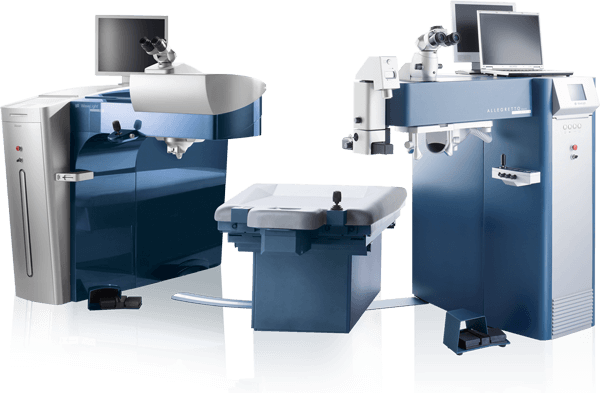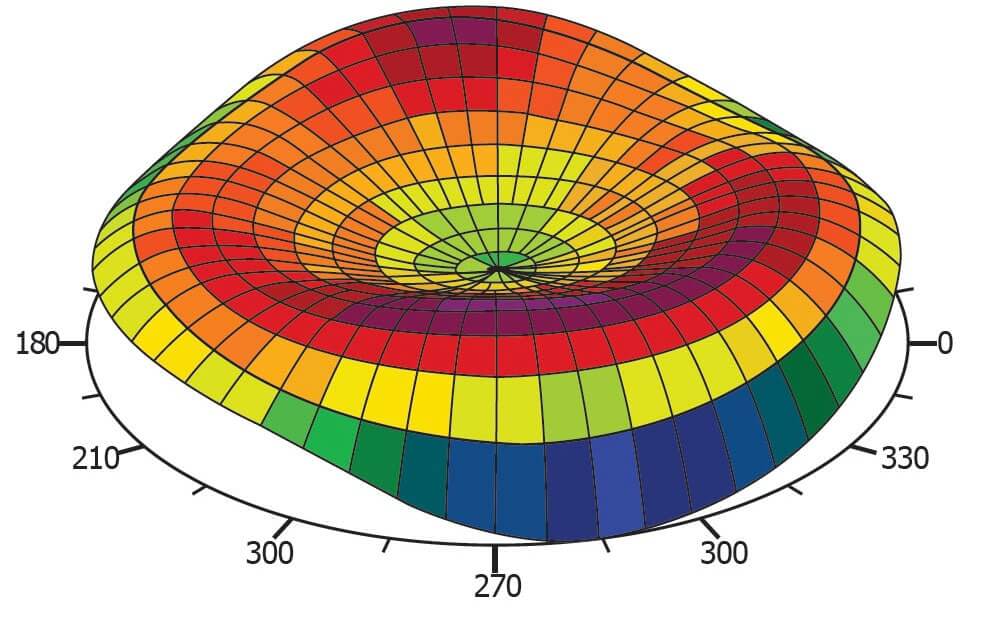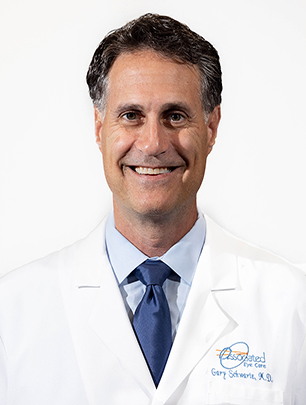LASIK

LASIK
Imagine waking up to see the world with crisp, brilliant clarity and less dependence on glasses or contact lenses. With life-changing LASIK from Associated Eye Care, you'll be able to play sports, swim, go to the movies, and enjoy social activities like never before!
What is lasik?
LASIK is a laser eye surgery that aims to correct common refractive errors, such as nearsightedness, farsightedness, and astigmatism. For those who are candidates, LASIK can provide a solution for gaining vision with crisp, brilliant clarity and less dependence on glasses or contact lenses.

Who is a Good Candidate for LASIK?
At Associated Eye Care, our LASIK surgeons perform thorough pre-operative examinations to ensure you're a good candidate. We won't recommend LASIK unless we're confident it's the right choice for you.
Fortunately, the vast majority of people are excellent candidates for the procedure. To be a good candidate for LASIK, you must be over the age of 18 and have healthy eyes. It's also important that you have had stable vision for at least a year or two, meaning that your contact lens or glasses prescription hasn't changed significantly over that period of time.
One of the most important factors for LASIK candidacy is corneal thickness. In order for LASIK to be safe and effective, your cornea must be thick enough for your LASIK surgeon to be able to make the flap, a necessary step in the LASIK procedure. If your cornea is too thin for LASIK, alternative procedures, like PRK, may still be a safe option.
Although many people experience complete freedom from glasses and contacts after LASIK, glasses may still be helpful for some activities. This may include things like night driving or reading for individuals over 40 years of age. Most people experience decades of clear vision after LASIK, but occasionally eyes change in the years after LASIK. When this occurs, it is often possible to perform an enhancement procedure to fine-tune the vision again.
Explore whether LASIK can free you from glasses or contacts and enhance your active lifestyle.
take our LASIK self-testWhat Happens During LASIK?
The cornea is the window at the front of the eye, which helps focus light and provide clear vision. During your LASIK procedure, the experienced surgeons at Associated Eye Care use advanced laser technology to reshape the cornea, correcting vision problems with precision and accuracy.
The procedure is quick and relatively painless. First, your eye doctor will place numbing drops on the surface of your cornea to ensure your comfort. Next, they will use a laser to create a flap in the top layer of the cornea. This flap is then lifted to expose the inner layers of the cornea.
Your LASIK surgeon will then ask you to look toward a light on a different laser and will then use the laser to reshape your cornea and correct your glasses prescription. This process takes only seconds to complete!
Thanks to advanced technology used by the LASIK surgeons at Associated Eye Care, you won't have to worry about slight movements in your eyes, as the software can adjust for any minor changes in eye positioning during your treatment. Once the reshaping is completed, your eye doctor will reposition the flap.
The team at Associated Eye Care will provide you with a list of instructions to follow during your recovery to help with proper healing.






LASIK Technology at Associated Eye Care
At Associated Eye Care, our LASIK surgeons are proud to offer some of the most innovative LASIK technology available.
WaveLight® EX500 Excimer Laser
The WaveLight® EX500 Excimer Laser suite is an FDA-approved laser system that features a 500 Hz speed to allow for extremely short treatment times. Most LASIK treatments take under 30 seconds.
The state-of-the-art treatment and safety features of the WaveLight® EX500 Excimer Laser allow our surgeons to perform exceptionally accurate and safe treatments to deliver outstanding outcomes.


Contoura® Vision
Associated Eye Care is also proud to offer Contoura® Vision topography-guided LASIK, which maps up to 22,000 unique elevation points on each eye for a treatment plan that is uniquely yours. This level of customization allows for unprecedented precision in treatment.
Each treatment plan is uniquely customized based on your eye's specific topography. The system analyzes thousands of data points to create a precise map of your cornea, allowing for the correction of even subtle irregularities in corneal shape.
All-Laser LASIK Package
As part of our commitment to providing exceptional care, Associated Eye Care makes this advanced technology available to all eligible LASIK candidates without additional cost.
Our All-Laser LASIK package includes the following for $1995/eye:
Free preoperative consultation with a LASIK surgeon
All-laser LASIK with Contoura Vision
Lifetime coverage for your results
Post-operative antibiotic/steroid eye drops
All post-operative visits and testing
Voucher for $100 off sunglasses from AEC Optical
24-month interest-free financing available


What is LASIK Recovery Like?
Recovery from LASIK is typically quick and comfortable. Our dedicated team provides comprehensive post-operative care to ensure the healing is smooth and successful.
After your numbing drops wear off, you may have a few hours of eye irritation and sensitivity. Typically, the eyes feel much better that evening and fairly comfortable the next morning.
Most normal activities can be resumed the day after surgery, though your doctor may advise you to avoid some higher-risk activities for a few weeks. You will also need to be careful not to rub your eyes, as this can disturb the healing of the flap.
Your eye doctor will instruct you on what eye drops you need to take to help prevent any inflammation or infection. Make sure to take these exactly as directed.
You will need to see your eye doctor for a series of follow-up visits after the procedure so that they can ensure your eyes are healing and your vision is improving. Vision is usually fairly clear within a few days of surgery, but complete healing may take anywhere from a couple of weeks to a few months.
What is Monovision LASIK?
The lens inside the eye becomes stiffer with age and loses its ability to bring close objects into clear focus. LASIK can restore some degree of near vision using a technique called “monovision” or “blended vision.”
With monovision, the dominant eye is corrected to focus at far distances, and the non-dominant eye is corrected to focus at near. Using the two eyes together, the brain can comprehend distant and near images.
Monovision treatments are commonly recommended to patients over 40 to reduce the need for reading glasses. Monovision LASIK is not right for everyone, as some individuals may have difficulty adapting to the difference in focus between their eyes.
It's important to have a thorough discussion with your eye doctor about your visual needs, lifestyle, and expectations to determine if monovision LASIK is the right choice for you. Regular follow-up care is essential to monitor healing and ensure optimal visual outcomes.
request appointment
lasik pricing

How Much Does LASIK Cost?
Navigating through financing options for LASIK can be stressful. At Associated Eye Care, our staff will present you with all the available options to help you select the one that is right for you. LASIK is an investment in your vision, and many people feel like the cost is well worth the visual freedom they gain. At Associated Eye Care, we offer a variety of financing options, including flexible interest plans, to make this life-changing procedure accessible to you.
Ophthalmologists performing LASIK eye surgery are certified by the American Board of Ophthalmology. Like other health procedures you may be considering, cost could be a top concern. While cost is no doubt an important factor, the overall quality of the care and provider, and visual outcomes should also be at the forefront when deciding whether LASIK is right for you.
Our All-Laser LASIK package includes the following for $1995/eye:
Free preoperative consultation with a LASIK surgeon
All-laser LASIK with Contoura Vision
Lifetime coverage for your results
Post-operative antibiotic/steroid eye drops
All post-operative visits and testing
Voucher for $100 off sunglasses from AEC Optical
24-month interest-free financing available
Can I Afford LASIK?
While the initial price of LASIK may seem steep at first, it is actually much more affordable than you think. If you use contact lenses to correct your vision, you may be surprised to find out that how much you pay for contact lenses every year is actually quite close to how much LASIK costs. When considering LASIK lets you live without contact lenses and eyeglasses for many years, the cost of LASIK is actually much cheaper long-term than contact lenses!
However, if the cost of LASIK still concerns you, there are many different available options to afford the procedure. Associated Eye Care offers financing options that can help make LASIK more affordable. There are also third party companies such as CareCredit that provide healthcare financing options for patients to allow procedures such as LASIK to become affordable on the spot!
One thing is certain, not only are the long-term benefits of LASIK worth the cost, but it will also be more cost-effective over the long-term!
request appointment financing
Do you want to learn more about LASIK or if you might be a good candidate for the procedure?
at Associated Eye Care today!



